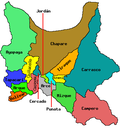| Location of Narciso Campero Province within Bolivia | |
|---|---|
 | |
| General Data | |
| Country | |
| Department | Cochabamba Department |
| Capital | Aiquile |
| Municipalities | 3 |
| Cantons | 10 |
| Area | 5,550 km2 |
| Elevation | m |
| Population | 36,146 (2024) |
| Density | 6.2 inhabitants/km2(2024) |
| Sub-prefect | |
| Languages | Quechua, Spanish |
| ISO 3166-2 | BO.CB.CM |
| Cochabamba Department | |
 | |
Narciso Campero is a province in the Cochabamba Department, Bolivia. Its capital is Aiquile. Aiquile lies on one transportation route between the cities of Cochabamba, Sucre and Santa Cruz.
